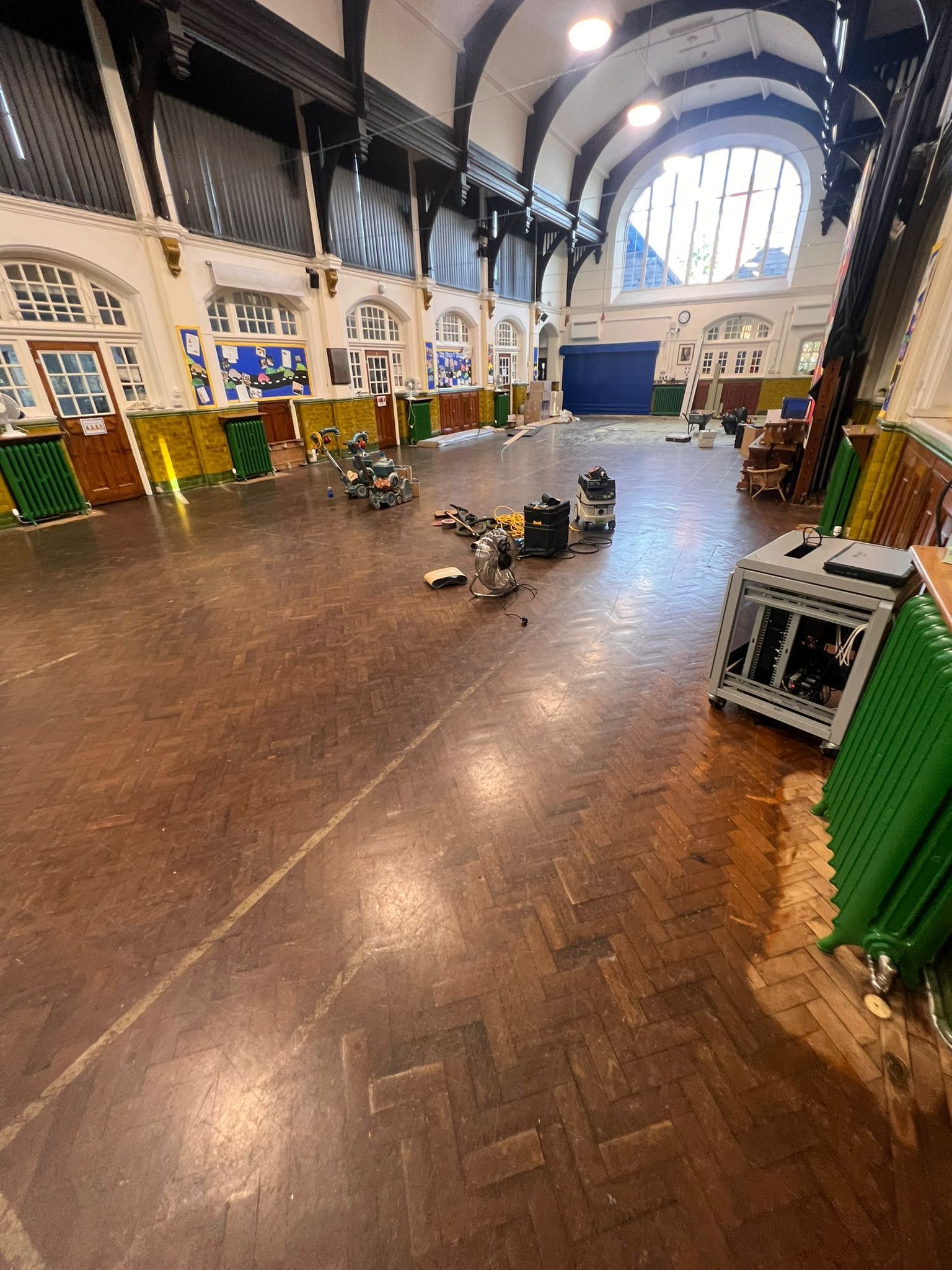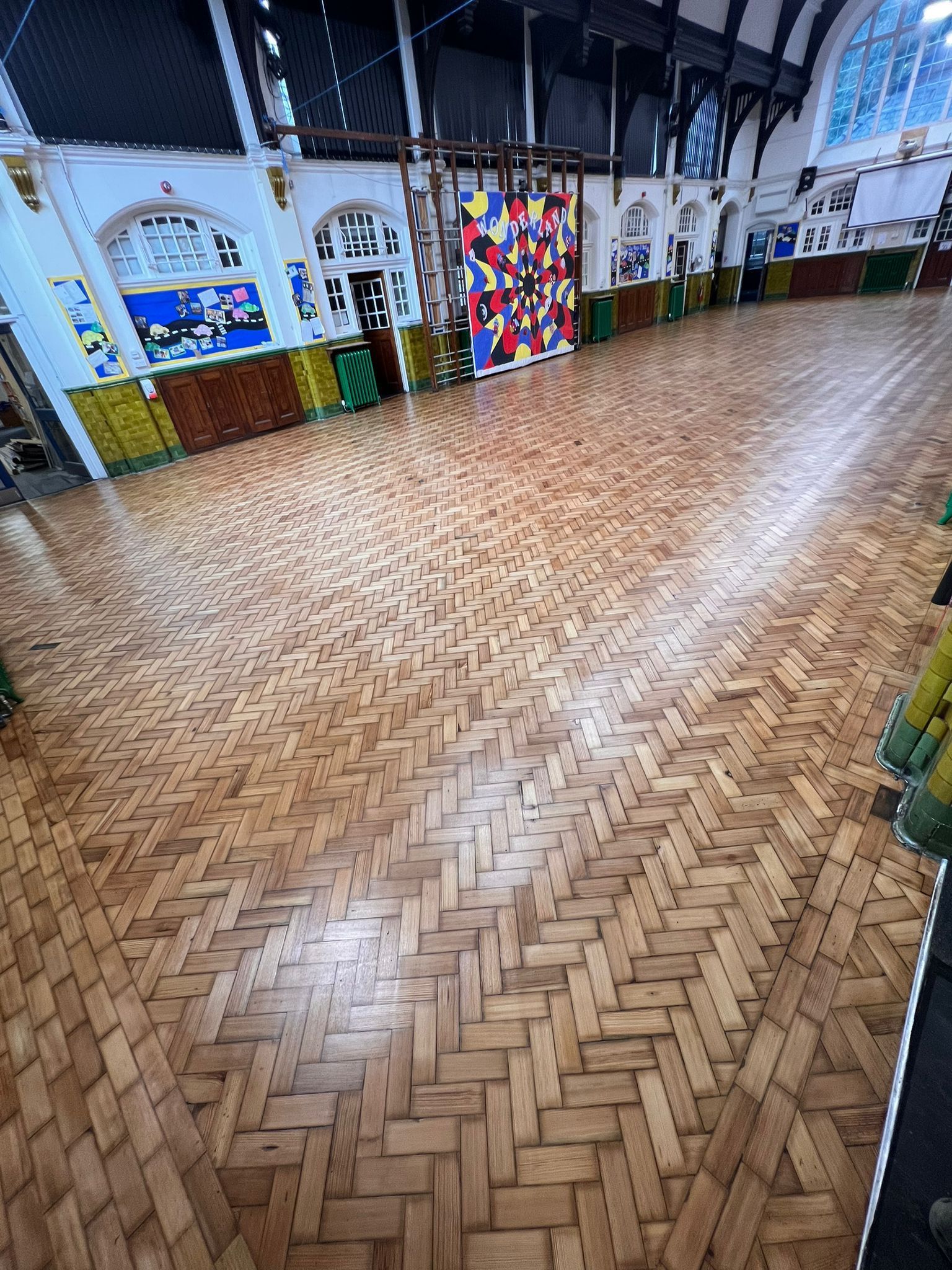Why Floor Finishes Are Crucial in Schools


Introduction
Schools are some of the busiest environments imaginable. Every day, hundreds or even thousands of students, teachers, and staff move through classrooms, corridors, gyms, and assembly halls. With this constant foot traffic, it’s no surprise that school floors take a beating.
From muddy shoes on rainy days to sports equipment scraping across gym floors, school flooring faces unique challenges. Without the right protection, wooden floors can quickly become scratched, stained, and worn, leading to expensive repairs and safety hazards.
That’s why floor finishes are crucial in schools. A finish doesn’t just make a floor look polished — it extends its lifespan, makes cleaning easier, and creates a safer, healthier environment for students and staff alike.
The Demands on School Flooring
Unlike residential or even commercial floors, school flooring has to handle:
- Heavy foot traffic: Hundreds of pupils walking the same corridors daily.
- Sports activity: Gym floors exposed to running, jumping, and equipment.
- Spills and mess: Food, drinks, paints, and cleaning products.
- Furniture movement: Desks, chairs, and stage setups constantly being rearranged.
- Hygiene requirements: Schools must maintain strict cleanliness standards.
With these challenges, an untreated or poorly finished floor would quickly deteriorate, becoming unsafe and unattractive.
Benefits of Floor Finishes in Schools
1. Durability and Longevity
School budgets are tight, and flooring is a major investment. A protective finish shields wood from scratches, scuffs, and stains, dramatically extending its life. Instead of replacing floors every few years, schools can maintain them for decades with the right care.
2. Safety First
Slippery or uneven floors are a risk for students. Many modern finishes include anti-slip properties, helping to reduce accidents in high-traffic areas like gymnasiums or dining halls.
3. Easy Cleaning and Maintenance
With hundreds of pupils using the same space daily, cleaning must be quick and efficient. Finishes like lacquer create smooth, sealed surfaces that resist spills and make mopping easier. This reduces cleaning time and ensures classrooms and corridors stay hygienic.
4. Improved Appearance
First impressions matter — even in schools. Shiny, well-kept floors create a sense of order and pride, whether during parent visits, inspections, or school events. Floors that look clean and polished reflect positively on the entire learning environment.
5. Cost Efficiency
Applying and maintaining a finish is far cheaper than replacing damaged flooring. For schools operating on tight budgets, this makes floor finishes a smart long-term investment.
Floor Finish Options for Schools
When it comes to educational settings, three finishes are most commonly considered: lacquer, oil, and wax. Each offers different benefits.
Lacquer Finish: Tough and Low-Maintenance
What It Is:
A lacquer finish creates a strong, sealed surface over the wood, offering excellent resistance to wear.
Pros:
- Extremely durable, ideal for high-traffic corridors and halls.
- Resistant to spills and stains.
- Easy to clean and maintain.
- Available in matte, satin, or gloss finishes.
Cons:
- Harder to repair — scratches usually require full re-sanding.
- Can look “shiny” if a matte or satin version isn’t chosen.
Best For:
- School corridors, dining halls, and assembly halls.
- Any area where low maintenance and high durability are essential.
Oil Finish: Natural and Repairable
What It Is:
Oil penetrates deep into the wood fibers, enhancing the grain while offering protection.
Pros:
- Natural look that hides minor scratches.
- Easy to spot-repair without full re-sanding.
- Flexible surface that doesn’t crack or peel.
Cons:
- Requires re-oiling every 1–2 years in busy environments.
- Less resistant to moisture and heavy spills than lacquer.
Best For:
- Classrooms or libraries where traffic is steady but not extreme.
- Schools that value a warm, natural aesthetic.
Wax Finish: Traditional but High-Maintenance
What It Is:
Wax is a traditional finish that creates a soft sheen and rich patina.
Pros:
- Creates a classic, authentic look.
- Easy to repair small sections.
- Eco-friendly options available.
Cons:
- Requires frequent reapplication and buffing.
- Not durable enough for high-traffic areas.
- Vulnerable to spills and scuffs.
Best For:
- Heritage school buildings or decorative halls with limited use.
Choosing the Right Finish for Different School Areas
Schools often require different finishes in different spaces:
- Corridors & Entrances: Lacquer for maximum durability.
- Classrooms: Oil for a balance of durability and natural look.
- Sports Halls & Gyms: Specialized lacquer with anti-slip properties.
- Assembly Halls: Lacquer or wax, depending on traffic and aesthetics.
- Libraries & Staff Rooms: Oil for warmth and repairability.
Maintenance Tips for School Floor Finishes
To maximize the life of school floors, regular care is essential:
- Sweep and vacuum daily to remove grit that causes scratches.
- Use mats at entrances to catch dirt and moisture.
- Clean spills immediately to prevent stains.
- Reapply oil or wax finishes on schedule.
- Consider a professional maintenance plan for lacquered floors.
Professional Application vs. DIY in Schools
While some schools attempt in-house maintenance, professional sanding and finishing services are usually the best option. Professionals provide:
- Dust-free sanding technology (essential in health-sensitive environments).
- Commercial-grade finishes for maximum durability.
- Faster turnaround, minimizing disruption to school schedules.
If you’re searching online for “school floor sanding and finishing near me”, look for companies with proven experience in educational settings.
Recent Example: School Assembly Floor Transformation
We recently restored an assembly hall in a primary school based in Stockport with a matte lacquer finish. Years of foot traffic had left the surface dull and unsafe. After sanding and applying a high-durability lacquer with anti-slip properties, the floor looked brand new.
Teachers noticed reduced cleaning time, and students benefited from a safer, more professional surface. Parents touring the school also commented positively on the improved appearance.
Conclusion
In schools, flooring isn’t just a background feature — it’s part of the learning environment. Floor finishes are crucial in schools because they protect against heavy use, improve safety, reduce cleaning time, and save money in the long run.
- Lacquer is best for high-traffic, low-maintenance durability.
- Oil offers a warm, repairable finish for classrooms.
- Wax adds character in heritage areas but requires more upkeep.
By choosing the right finish for each space, schools can create a safe, attractive, and cost-effective environment that supports learning for years to come.
✨ Ready to improve your school floors? Contact us today for a free consultation on floor sanding and finishing for schools.
